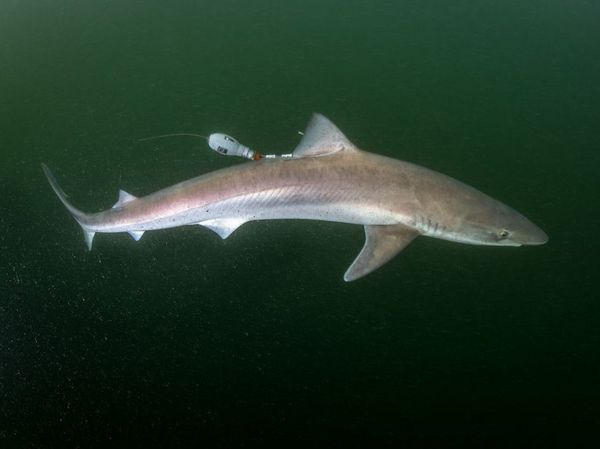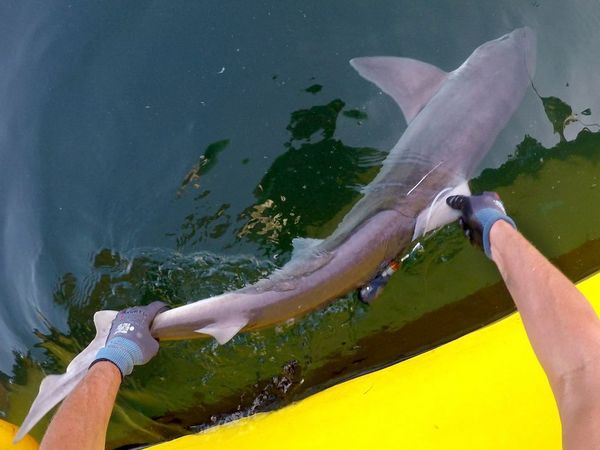From the German Bight into the deep sea: The amazing migration of tope
Investigations on migration paths of adult tope by scientists from the Thünen Institute yielded a surprising discovery: Some individuals of the threatened sharks did not only migrate from the shallow, southern North Sea into the open Atlantic, but also engaged in extensive vertical migrations into deeper realms. The sharks are believed to follow the diel migration patterns of their preferred prey – squid. Squid, like other mesopelagic species, perform daily migrations from depths of several hundred meters to the surface and back. This could be shown by the researchers through a combination of location and depth data from pop-up satellite tags attached to individual tope and hydroacoustic echosounder survey data from several scientific expeditions in the North Atlantic.
Tope – a shark species that can grow up to 2 m in length- are generally considered inhabitants of continental shelfs and shallow coastal seas, but have been observed offshore and in greater depths before. Sample data from the satellite tags deployed on tope near the German island Helgoland corroborated this. It came as a surprise to the scientists that some of the tagged sharks did not only undertake wide ranging migrations into the open Atlantic (one specimen travelled into waters near the Portuguese island Madeira in the subtropical Atlantic), but also displayed a profound change in diving behavior descending into depths occasionally exceeding 700 meters.
A closer look at depth distribution data from the tagged sharks showed a recurring diel pattern in depth occupancy: In open areas of the Atlantic Ocean, the sharks remained in surface layers of about 150 m depths during nighttime and descended into depths of 400 to 600 m at dawn, where they remained during daytime until dusk, when they started to ascend towards the surface again.
As part of a current study that is now published in Scientific Reports, the team of German, Scottish, Dutch and Spanish scientists compared depth profiles from satellite tags with hydroacoustic data recorded with echosounders during several scientific expeditions in the Northeast Atlantic. In all open oceans, prominent dense layers of a mixture of organisms occur in several hundred meters depth. These can be detected with echosounders– the so-called deep scattering layers. These layers are characterized by a high abundance and biomass of a variety of mesopelagic organisms. “By overlaying the sample data from the sharks and the echosounder data, we could clearly show that in the open waters of the Atlantic tope almost continuously tracked these scattering layers”, explains Dr. Matthias Schaber from the Thünen Institute of Sea Fisheries, lead author of the study. “Mesopelagic organisms – a variety of animals from small crustaceans and gelatinous zooplankton to cephalopods and bony fishes- mostly reside in depths where sunlight does not or only marginally penetrates. Many of those organisms undertake diel vertical migrations and ascend to surface layers in the cover of darkness at nighttime, returning to the dark depths of the ocean at dusk. This migration is, in terms of biomass, considered the largest animal migration on earth. And tope obviously join in.”
Schaber and his colleagues could furthermore show that the sharks remained largely in those parts of the scattering layers that were characterized by a high probability of encountering squid. “Tope apparently change their swimming behavior in open ocean areas. Instead of staying in the surface layers that are considered comparatively poor in prey availability, they adopt their behavior to feed on their preferred prey –squid- in the rich environment of the mesopelagic deep scattering layers.”, says Dr. Schaber. “This has not been evidenced as detailed before.”
Tope are deemed „critically endangered“ globally and are listed as „endangered” in the German national Red List of threatened species due to decades of overfishing. Slow growth, late maturity and low fecundity render this shark particularly vulnerable to both targeted fisheries and incidental catch in a variety of fishing gears. To identify critical habitats, i.e. possible pupping areas, nursery grounds or other aggregation sites, and to derive measures to better protect the species, scientists from the Thünen Institute of Sea Fisheries have been tagging adult tope sharks with satellite tags during their summer aggregations around Helgoland island since 2017.
Original publication
Schaber, M., Gastauer, S., Cisewski, B. et al. Extensive oceanic mesopelagic habitat use of a migratory continental shark species. Sci Rep 12, 2047 (2022). https://doi.org/10.1038/s41598-022-05989-z




![[Translate to English:] Logo des Bundesministerium für Ernährung und Landwirtschaft](/media/allgemein/logos/BMEL_Logo.svg)